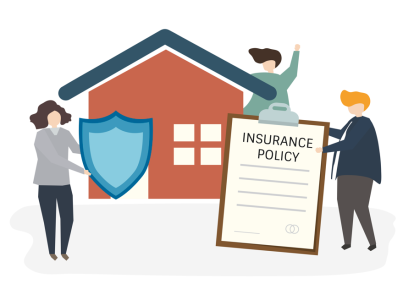Report reveals Aussies skimp on crucial insurance amid cost of living crisis
Australia is known for its wild weather, from torrential storms to damaging hail, flooding, and cyclones.
These natural disasters can wreak havoc on homes and possessions, leaving homeowners with hefty bills for repairs and replacements.
But as the cost of living continues to rise, more and more Australians are choosing to forego a crucial safety net: home and contents insurance.
A recent survey by Compare the Market revealed a startling statistic: over a quarter of Australians, or 26.5 per cent, do not have home or contents insurance.
This leaves them vulnerable to the financial impact of wild weather events, which have been increasing in frequency and severity due to climate change.

Home insurance provides coverage for the physical structure of the house, while contents insurance covers the items inside, such as furniture, clothes, and electronics.
Without these protections, homeowners could face significant out-of-pocket expenses in the event of a disaster.
Adrian Taylor, Compare the Market’s Executive General Manager for General Insurance, warned that insurance premiums are likely to increase in 2024, making it even more costly to insure homes.
This is due to the rising costs of building materials and labour, as well as inflation affecting the cost of replacing household goods.
‘We’re not even far into 2024, and hundreds of thousands of Australians have already been impacted by torrential storms, damaging hail, flooding and cyclones,’ he said.
‘We’re continuing to experience these wild weather events while the building industry has seen the cost skyrocket for materials and labour to repair or build homes,’ Taylor added.
‘Similarly, inflation means the goods in our home will also cost more to replace. Unfortunately for everyday Aussies, this does come at the cost of higher premiums.’
Currently, the average cost of home and contents insurance in Australia is $1,741.30 annually.
However, this figure can vary greatly depending on factors such as location and risk of flooding or crime.
With the predicted rise in premiums, this cost could become even more prohibitive for many Australians.
The survey also revealed regional differences in insurance coverage. New South Wales (NSW) residents were the least likely to have home or contents insurance, with 33.1 per cent going without.
This is perhaps unsurprising given that Sydney is the most expensive city in the country. On the other end of the spectrum, only 14.7 per cent of South Australians (SA) lack coverage.
Generational differences were also evident. Baby Boomers and Millennials were more likely to have insurance than Gen Z homeowners.
Less than half of Gen Z’ers have home/contents coverage at 41.5 per cent, while Baby Boomers have 85.1 per cent coverage and Millennials are at 71.5 per cent.
Taylor suggested that younger generations may be less aware of the risks of going without insurance.
'If you are moving out of home or to a new area, it’s vital that you do your research,' he advised.
While the housing market can be difficult to navigate for everyone, it does present additional challenges for younger Australians.
In 2022, the Australian Bureau of Statistics reported that the likelihood of owning a home between the ages of 25 and 39 has decreased with each successive generation.
Millennials were three times less likely to own their home without a mortgage than Baby Boomers were at the same age.
In 2023, the average home price is $920,100, while the average income is $90,896. This means that the average Australian would need to pay up to ten times their annual income to buy a home without a mortgage.
Last year, it was reported that van living is becoming a popular trend among younger Australians, driven by factors such as the cost of living crisis and rising rent prices.
Additionally, seniors who are renting are also affected by its rising costs.
National Seniors Chief Operating Officer Chris Grice said that the rental crisis has left many seniors in rural areas financially vulnerable, as they were initially assumed to own their homes when the Aged Pension was designed and now struggle with the cost of living due to increased renting.
Some, like these seniors in Queensland, have turned to sharehouses as an affordable rental solution.

What are your thoughts on this, members? Have you had to forego insurance due to the cost? Share your experiences in the comments below.
These natural disasters can wreak havoc on homes and possessions, leaving homeowners with hefty bills for repairs and replacements.
But as the cost of living continues to rise, more and more Australians are choosing to forego a crucial safety net: home and contents insurance.
A recent survey by Compare the Market revealed a startling statistic: over a quarter of Australians, or 26.5 per cent, do not have home or contents insurance.
This leaves them vulnerable to the financial impact of wild weather events, which have been increasing in frequency and severity due to climate change.

Compare the Market stated that 26.5 per cent of Aussies don’t have home or contents insurance. Image source: Freepik
Home insurance provides coverage for the physical structure of the house, while contents insurance covers the items inside, such as furniture, clothes, and electronics.
Without these protections, homeowners could face significant out-of-pocket expenses in the event of a disaster.
Adrian Taylor, Compare the Market’s Executive General Manager for General Insurance, warned that insurance premiums are likely to increase in 2024, making it even more costly to insure homes.
This is due to the rising costs of building materials and labour, as well as inflation affecting the cost of replacing household goods.
‘We’re not even far into 2024, and hundreds of thousands of Australians have already been impacted by torrential storms, damaging hail, flooding and cyclones,’ he said.
‘We’re continuing to experience these wild weather events while the building industry has seen the cost skyrocket for materials and labour to repair or build homes,’ Taylor added.
‘Similarly, inflation means the goods in our home will also cost more to replace. Unfortunately for everyday Aussies, this does come at the cost of higher premiums.’
Currently, the average cost of home and contents insurance in Australia is $1,741.30 annually.
However, this figure can vary greatly depending on factors such as location and risk of flooding or crime.
With the predicted rise in premiums, this cost could become even more prohibitive for many Australians.
The survey also revealed regional differences in insurance coverage. New South Wales (NSW) residents were the least likely to have home or contents insurance, with 33.1 per cent going without.
This is perhaps unsurprising given that Sydney is the most expensive city in the country. On the other end of the spectrum, only 14.7 per cent of South Australians (SA) lack coverage.
Generational differences were also evident. Baby Boomers and Millennials were more likely to have insurance than Gen Z homeowners.
Less than half of Gen Z’ers have home/contents coverage at 41.5 per cent, while Baby Boomers have 85.1 per cent coverage and Millennials are at 71.5 per cent.
Taylor suggested that younger generations may be less aware of the risks of going without insurance.
'If you are moving out of home or to a new area, it’s vital that you do your research,' he advised.
While the housing market can be difficult to navigate for everyone, it does present additional challenges for younger Australians.
In 2022, the Australian Bureau of Statistics reported that the likelihood of owning a home between the ages of 25 and 39 has decreased with each successive generation.
Millennials were three times less likely to own their home without a mortgage than Baby Boomers were at the same age.
In 2023, the average home price is $920,100, while the average income is $90,896. This means that the average Australian would need to pay up to ten times their annual income to buy a home without a mortgage.
Last year, it was reported that van living is becoming a popular trend among younger Australians, driven by factors such as the cost of living crisis and rising rent prices.
Additionally, seniors who are renting are also affected by its rising costs.
National Seniors Chief Operating Officer Chris Grice said that the rental crisis has left many seniors in rural areas financially vulnerable, as they were initially assumed to own their homes when the Aged Pension was designed and now struggle with the cost of living due to increased renting.
Some, like these seniors in Queensland, have turned to sharehouses as an affordable rental solution.
Key Takeaways
- Over a quarter of Australians do not have home or contents insurance, which could leave them vulnerable to costs from wild weather damage.
- The cost of living crisis is contributing to Australians foregoing insurance, as premiums are expected to rise in 2024.
- New South Wales residents have the highest rate of people without home and/or contents insurance, while South Australians have the lowest.
- Younger generations, especially Gen Z, are less likely to have insurance compared to Baby Boomers and Millennials, potentially due to a lack of awareness and financial constraints in the housing market.
What are your thoughts on this, members? Have you had to forego insurance due to the cost? Share your experiences in the comments below.







